NSG 3101: Case Study of Inpatient Rehabilitation for TBI Patient
VerifiedAdded on 2022/08/13
|13
|3648
|23
Case Study
AI Summary
This case study delves into the inpatient rehabilitation of a patient, Paula, who suffered a traumatic brain injury (TBI). The assignment outlines three key rehabilitation goals: addressing dysphasia (language impairment), dysphagia (swallowing difficulties), and impaired mobility. The solution details the interventions for each goal, including speech and language therapy, non-instrumental swallowing assessments, physiotherapy, and occupational therapy. Furthermore, the case study emphasizes the importance of comprehensive discharge planning, involving the patient, family, and a multidisciplinary team to ensure a smooth transition from the rehabilitation setting. The planning includes providing information about potential complications, medication management, dietary requirements, and necessary support services like meals-on-wheels and mobility aids. The case study highlights the collaborative efforts of various healthcare professionals, including nurses, therapists, and dieticians, in achieving the patient's recovery and improving their quality of life.

Running head: CASE STUDY
Part 2: Written Component
Name of the Student
Name of the University
Author Note
Part 2: Written Component
Name of the Student
Name of the University
Author Note
Paraphrase This Document
Need a fresh take? Get an instant paraphrase of this document with our AI Paraphraser
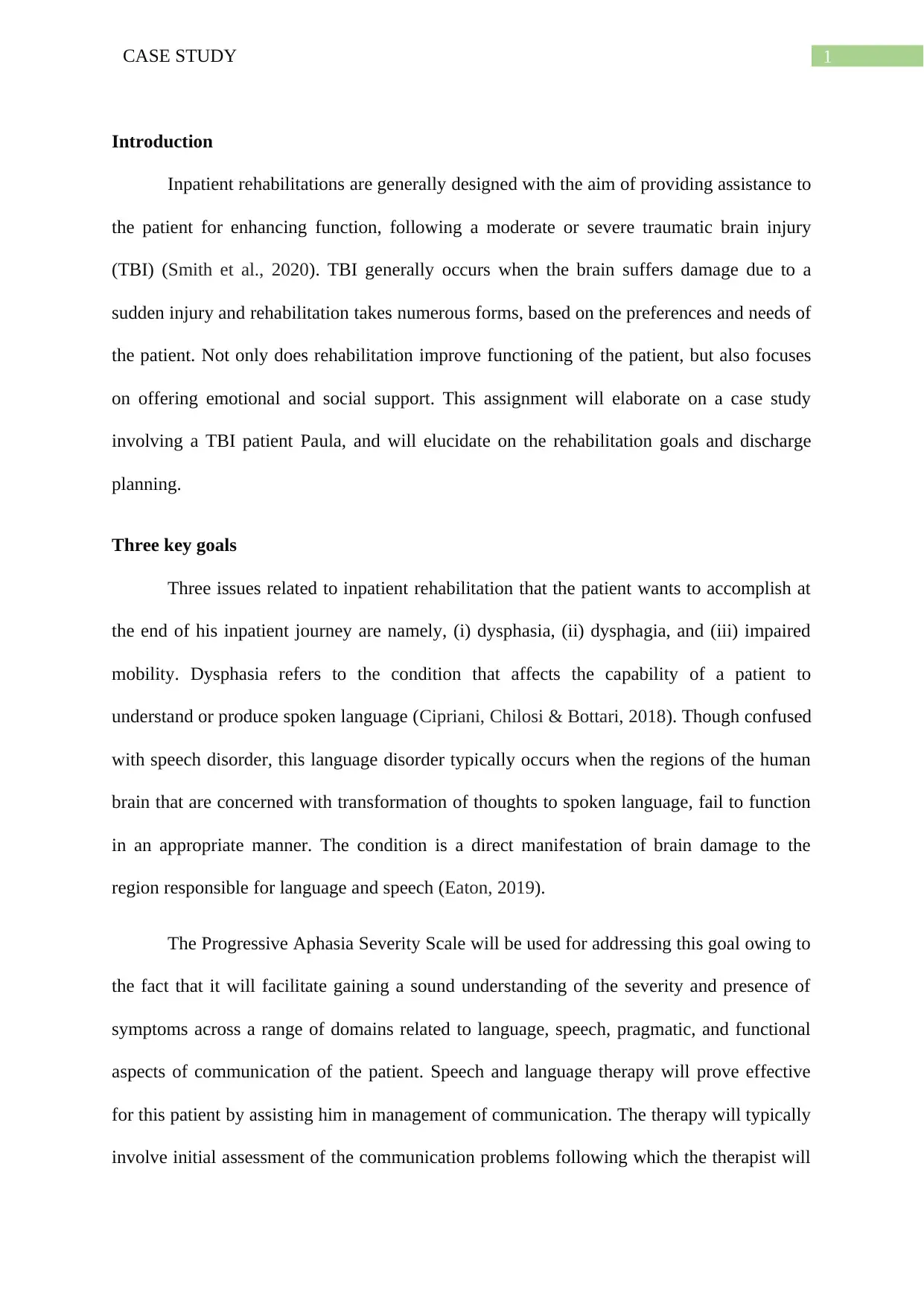
1CASE STUDY
Introduction
Inpatient rehabilitations are generally designed with the aim of providing assistance to
the patient for enhancing function, following a moderate or severe traumatic brain injury
(TBI) (Smith et al., 2020). TBI generally occurs when the brain suffers damage due to a
sudden injury and rehabilitation takes numerous forms, based on the preferences and needs of
the patient. Not only does rehabilitation improve functioning of the patient, but also focuses
on offering emotional and social support. This assignment will elaborate on a case study
involving a TBI patient Paula, and will elucidate on the rehabilitation goals and discharge
planning.
Three key goals
Three issues related to inpatient rehabilitation that the patient wants to accomplish at
the end of his inpatient journey are namely, (i) dysphasia, (ii) dysphagia, and (iii) impaired
mobility. Dysphasia refers to the condition that affects the capability of a patient to
understand or produce spoken language (Cipriani, Chilosi & Bottari, 2018). Though confused
with speech disorder, this language disorder typically occurs when the regions of the human
brain that are concerned with transformation of thoughts to spoken language, fail to function
in an appropriate manner. The condition is a direct manifestation of brain damage to the
region responsible for language and speech (Eaton, 2019).
The Progressive Aphasia Severity Scale will be used for addressing this goal owing to
the fact that it will facilitate gaining a sound understanding of the severity and presence of
symptoms across a range of domains related to language, speech, pragmatic, and functional
aspects of communication of the patient. Speech and language therapy will prove effective
for this patient by assisting him in management of communication. The therapy will typically
involve initial assessment of the communication problems following which the therapist will
Introduction
Inpatient rehabilitations are generally designed with the aim of providing assistance to
the patient for enhancing function, following a moderate or severe traumatic brain injury
(TBI) (Smith et al., 2020). TBI generally occurs when the brain suffers damage due to a
sudden injury and rehabilitation takes numerous forms, based on the preferences and needs of
the patient. Not only does rehabilitation improve functioning of the patient, but also focuses
on offering emotional and social support. This assignment will elaborate on a case study
involving a TBI patient Paula, and will elucidate on the rehabilitation goals and discharge
planning.
Three key goals
Three issues related to inpatient rehabilitation that the patient wants to accomplish at
the end of his inpatient journey are namely, (i) dysphasia, (ii) dysphagia, and (iii) impaired
mobility. Dysphasia refers to the condition that affects the capability of a patient to
understand or produce spoken language (Cipriani, Chilosi & Bottari, 2018). Though confused
with speech disorder, this language disorder typically occurs when the regions of the human
brain that are concerned with transformation of thoughts to spoken language, fail to function
in an appropriate manner. The condition is a direct manifestation of brain damage to the
region responsible for language and speech (Eaton, 2019).
The Progressive Aphasia Severity Scale will be used for addressing this goal owing to
the fact that it will facilitate gaining a sound understanding of the severity and presence of
symptoms across a range of domains related to language, speech, pragmatic, and functional
aspects of communication of the patient. Speech and language therapy will prove effective
for this patient by assisting him in management of communication. The therapy will typically
involve initial assessment of the communication problems following which the therapist will
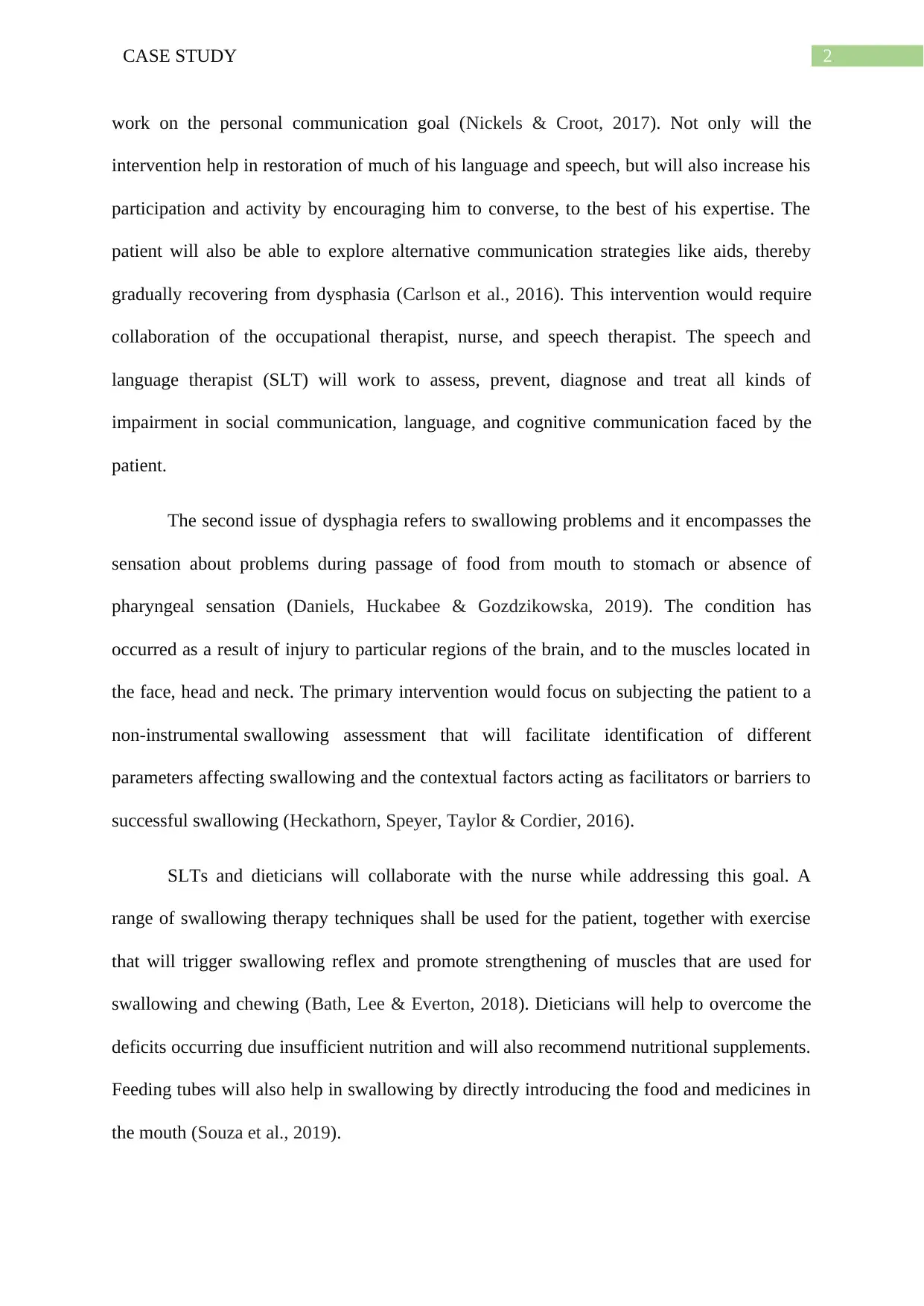
2CASE STUDY
work on the personal communication goal (Nickels & Croot, 2017). Not only will the
intervention help in restoration of much of his language and speech, but will also increase his
participation and activity by encouraging him to converse, to the best of his expertise. The
patient will also be able to explore alternative communication strategies like aids, thereby
gradually recovering from dysphasia (Carlson et al., 2016). This intervention would require
collaboration of the occupational therapist, nurse, and speech therapist. The speech and
language therapist (SLT) will work to assess, prevent, diagnose and treat all kinds of
impairment in social communication, language, and cognitive communication faced by the
patient.
The second issue of dysphagia refers to swallowing problems and it encompasses the
sensation about problems during passage of food from mouth to stomach or absence of
pharyngeal sensation (Daniels, Huckabee & Gozdzikowska, 2019). The condition has
occurred as a result of injury to particular regions of the brain, and to the muscles located in
the face, head and neck. The primary intervention would focus on subjecting the patient to a
non-instrumental swallowing assessment that will facilitate identification of different
parameters affecting swallowing and the contextual factors acting as facilitators or barriers to
successful swallowing (Heckathorn, Speyer, Taylor & Cordier, 2016).
SLTs and dieticians will collaborate with the nurse while addressing this goal. A
range of swallowing therapy techniques shall be used for the patient, together with exercise
that will trigger swallowing reflex and promote strengthening of muscles that are used for
swallowing and chewing (Bath, Lee & Everton, 2018). Dieticians will help to overcome the
deficits occurring due insufficient nutrition and will also recommend nutritional supplements.
Feeding tubes will also help in swallowing by directly introducing the food and medicines in
the mouth (Souza et al., 2019).
work on the personal communication goal (Nickels & Croot, 2017). Not only will the
intervention help in restoration of much of his language and speech, but will also increase his
participation and activity by encouraging him to converse, to the best of his expertise. The
patient will also be able to explore alternative communication strategies like aids, thereby
gradually recovering from dysphasia (Carlson et al., 2016). This intervention would require
collaboration of the occupational therapist, nurse, and speech therapist. The speech and
language therapist (SLT) will work to assess, prevent, diagnose and treat all kinds of
impairment in social communication, language, and cognitive communication faced by the
patient.
The second issue of dysphagia refers to swallowing problems and it encompasses the
sensation about problems during passage of food from mouth to stomach or absence of
pharyngeal sensation (Daniels, Huckabee & Gozdzikowska, 2019). The condition has
occurred as a result of injury to particular regions of the brain, and to the muscles located in
the face, head and neck. The primary intervention would focus on subjecting the patient to a
non-instrumental swallowing assessment that will facilitate identification of different
parameters affecting swallowing and the contextual factors acting as facilitators or barriers to
successful swallowing (Heckathorn, Speyer, Taylor & Cordier, 2016).
SLTs and dieticians will collaborate with the nurse while addressing this goal. A
range of swallowing therapy techniques shall be used for the patient, together with exercise
that will trigger swallowing reflex and promote strengthening of muscles that are used for
swallowing and chewing (Bath, Lee & Everton, 2018). Dieticians will help to overcome the
deficits occurring due insufficient nutrition and will also recommend nutritional supplements.
Feeding tubes will also help in swallowing by directly introducing the food and medicines in
the mouth (Souza et al., 2019).
⊘ This is a preview!⊘
Do you want full access?
Subscribe today to unlock all pages.

Trusted by 1+ million students worldwide
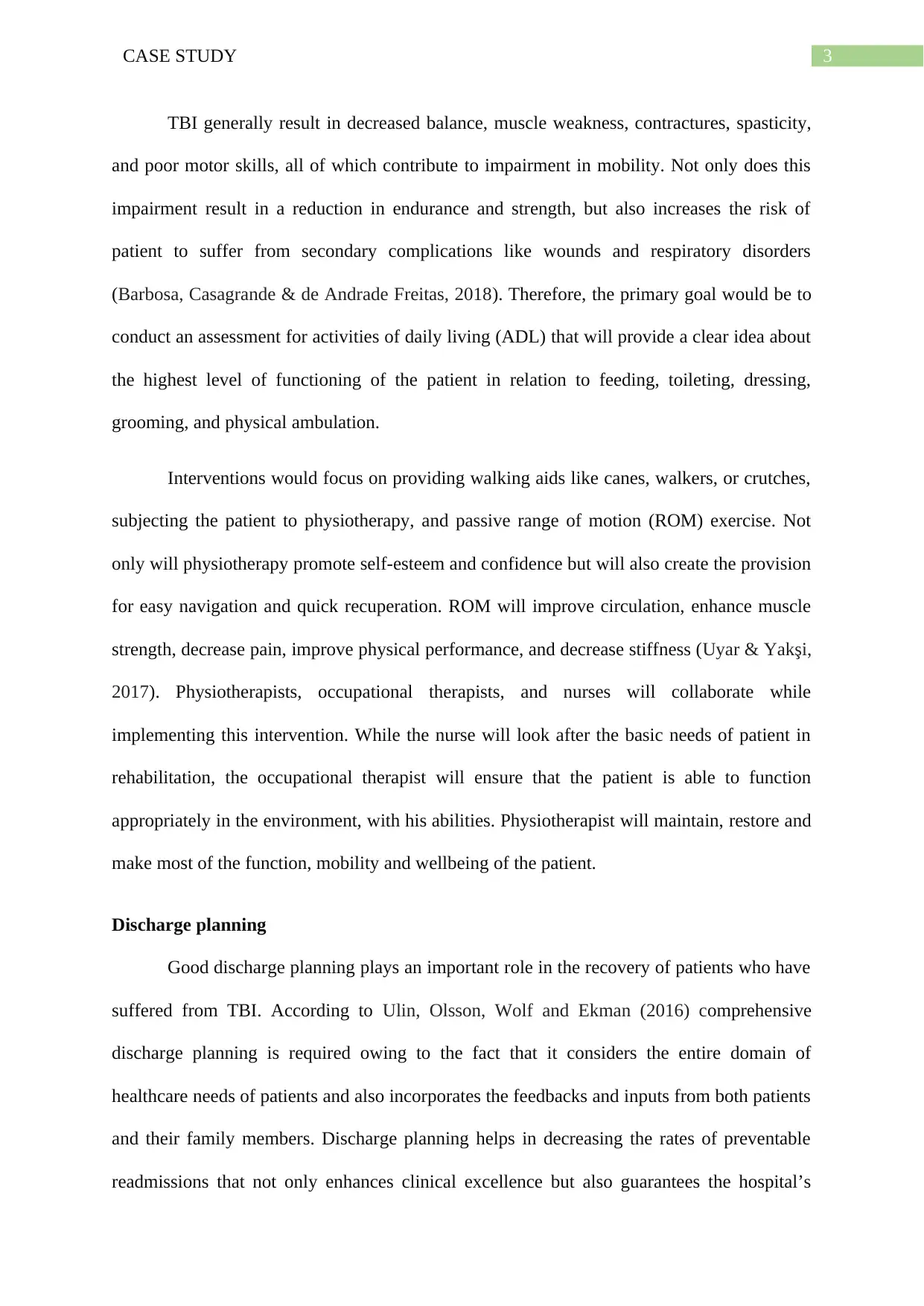
3CASE STUDY
TBI generally result in decreased balance, muscle weakness, contractures, spasticity,
and poor motor skills, all of which contribute to impairment in mobility. Not only does this
impairment result in a reduction in endurance and strength, but also increases the risk of
patient to suffer from secondary complications like wounds and respiratory disorders
(Barbosa, Casagrande & de Andrade Freitas, 2018). Therefore, the primary goal would be to
conduct an assessment for activities of daily living (ADL) that will provide a clear idea about
the highest level of functioning of the patient in relation to feeding, toileting, dressing,
grooming, and physical ambulation.
Interventions would focus on providing walking aids like canes, walkers, or crutches,
subjecting the patient to physiotherapy, and passive range of motion (ROM) exercise. Not
only will physiotherapy promote self-esteem and confidence but will also create the provision
for easy navigation and quick recuperation. ROM will improve circulation, enhance muscle
strength, decrease pain, improve physical performance, and decrease stiffness (Uyar & Yakşi,
2017). Physiotherapists, occupational therapists, and nurses will collaborate while
implementing this intervention. While the nurse will look after the basic needs of patient in
rehabilitation, the occupational therapist will ensure that the patient is able to function
appropriately in the environment, with his abilities. Physiotherapist will maintain, restore and
make most of the function, mobility and wellbeing of the patient.
Discharge planning
Good discharge planning plays an important role in the recovery of patients who have
suffered from TBI. According to Ulin, Olsson, Wolf and Ekman (2016) comprehensive
discharge planning is required owing to the fact that it considers the entire domain of
healthcare needs of patients and also incorporates the feedbacks and inputs from both patients
and their family members. Discharge planning helps in decreasing the rates of preventable
readmissions that not only enhances clinical excellence but also guarantees the hospital’s
TBI generally result in decreased balance, muscle weakness, contractures, spasticity,
and poor motor skills, all of which contribute to impairment in mobility. Not only does this
impairment result in a reduction in endurance and strength, but also increases the risk of
patient to suffer from secondary complications like wounds and respiratory disorders
(Barbosa, Casagrande & de Andrade Freitas, 2018). Therefore, the primary goal would be to
conduct an assessment for activities of daily living (ADL) that will provide a clear idea about
the highest level of functioning of the patient in relation to feeding, toileting, dressing,
grooming, and physical ambulation.
Interventions would focus on providing walking aids like canes, walkers, or crutches,
subjecting the patient to physiotherapy, and passive range of motion (ROM) exercise. Not
only will physiotherapy promote self-esteem and confidence but will also create the provision
for easy navigation and quick recuperation. ROM will improve circulation, enhance muscle
strength, decrease pain, improve physical performance, and decrease stiffness (Uyar & Yakşi,
2017). Physiotherapists, occupational therapists, and nurses will collaborate while
implementing this intervention. While the nurse will look after the basic needs of patient in
rehabilitation, the occupational therapist will ensure that the patient is able to function
appropriately in the environment, with his abilities. Physiotherapist will maintain, restore and
make most of the function, mobility and wellbeing of the patient.
Discharge planning
Good discharge planning plays an important role in the recovery of patients who have
suffered from TBI. According to Ulin, Olsson, Wolf and Ekman (2016) comprehensive
discharge planning is required owing to the fact that it considers the entire domain of
healthcare needs of patients and also incorporates the feedbacks and inputs from both patients
and their family members. Discharge planning helps in decreasing the rates of preventable
readmissions that not only enhances clinical excellence but also guarantees the hospital’s
Paraphrase This Document
Need a fresh take? Get an instant paraphrase of this document with our AI Paraphraser
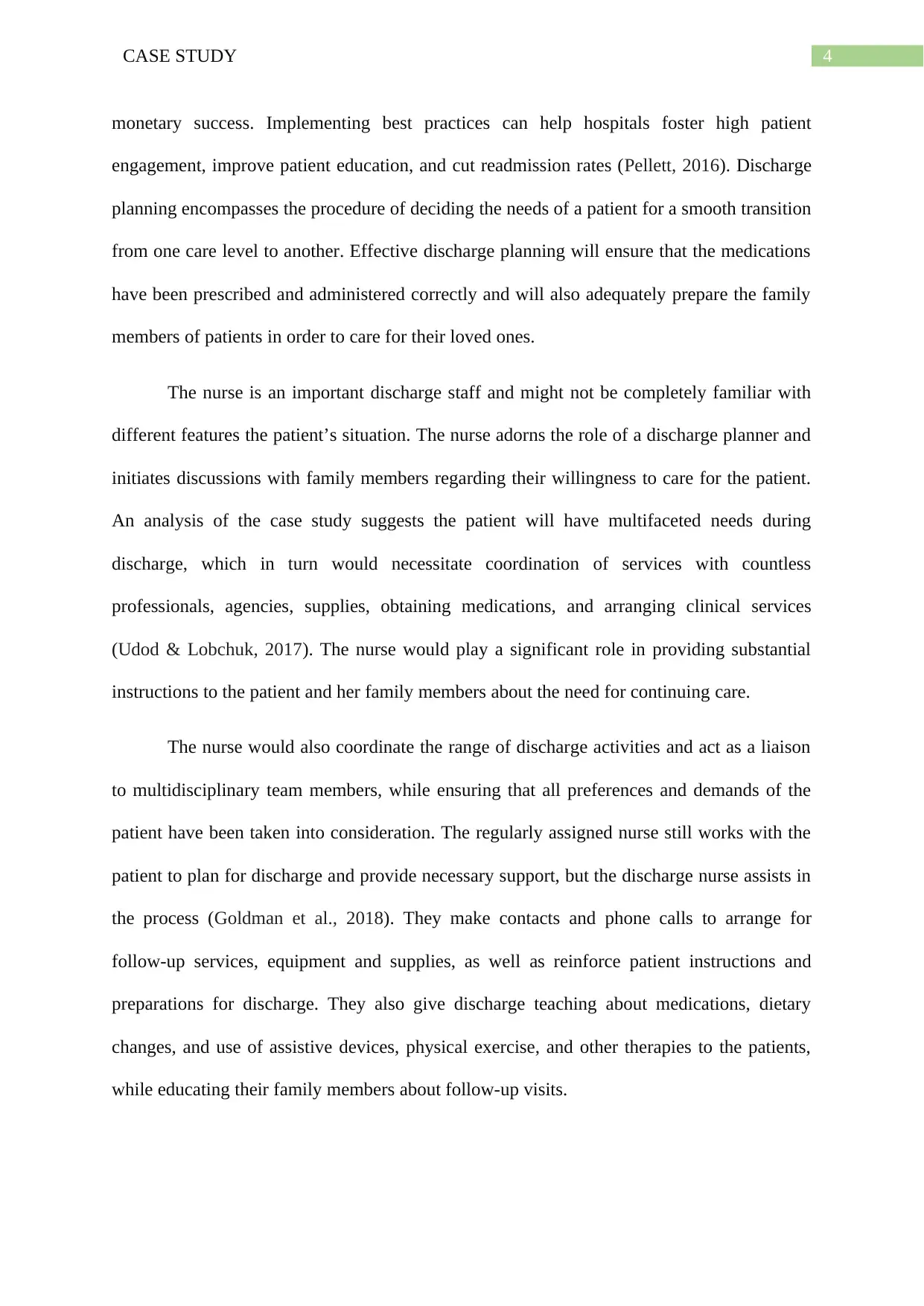
4CASE STUDY
monetary success. Implementing best practices can help hospitals foster high patient
engagement, improve patient education, and cut readmission rates (Pellett, 2016). Discharge
planning encompasses the procedure of deciding the needs of a patient for a smooth transition
from one care level to another. Effective discharge planning will ensure that the medications
have been prescribed and administered correctly and will also adequately prepare the family
members of patients in order to care for their loved ones.
The nurse is an important discharge staff and might not be completely familiar with
different features the patient’s situation. The nurse adorns the role of a discharge planner and
initiates discussions with family members regarding their willingness to care for the patient.
An analysis of the case study suggests the patient will have multifaceted needs during
discharge, which in turn would necessitate coordination of services with countless
professionals, agencies, supplies, obtaining medications, and arranging clinical services
(Udod & Lobchuk, 2017). The nurse would play a significant role in providing substantial
instructions to the patient and her family members about the need for continuing care.
The nurse would also coordinate the range of discharge activities and act as a liaison
to multidisciplinary team members, while ensuring that all preferences and demands of the
patient have been taken into consideration. The regularly assigned nurse still works with the
patient to plan for discharge and provide necessary support, but the discharge nurse assists in
the process (Goldman et al., 2018). They make contacts and phone calls to arrange for
follow-up services, equipment and supplies, as well as reinforce patient instructions and
preparations for discharge. They also give discharge teaching about medications, dietary
changes, and use of assistive devices, physical exercise, and other therapies to the patients,
while educating their family members about follow-up visits.
monetary success. Implementing best practices can help hospitals foster high patient
engagement, improve patient education, and cut readmission rates (Pellett, 2016). Discharge
planning encompasses the procedure of deciding the needs of a patient for a smooth transition
from one care level to another. Effective discharge planning will ensure that the medications
have been prescribed and administered correctly and will also adequately prepare the family
members of patients in order to care for their loved ones.
The nurse is an important discharge staff and might not be completely familiar with
different features the patient’s situation. The nurse adorns the role of a discharge planner and
initiates discussions with family members regarding their willingness to care for the patient.
An analysis of the case study suggests the patient will have multifaceted needs during
discharge, which in turn would necessitate coordination of services with countless
professionals, agencies, supplies, obtaining medications, and arranging clinical services
(Udod & Lobchuk, 2017). The nurse would play a significant role in providing substantial
instructions to the patient and her family members about the need for continuing care.
The nurse would also coordinate the range of discharge activities and act as a liaison
to multidisciplinary team members, while ensuring that all preferences and demands of the
patient have been taken into consideration. The regularly assigned nurse still works with the
patient to plan for discharge and provide necessary support, but the discharge nurse assists in
the process (Goldman et al., 2018). They make contacts and phone calls to arrange for
follow-up services, equipment and supplies, as well as reinforce patient instructions and
preparations for discharge. They also give discharge teaching about medications, dietary
changes, and use of assistive devices, physical exercise, and other therapies to the patients,
while educating their family members about follow-up visits.
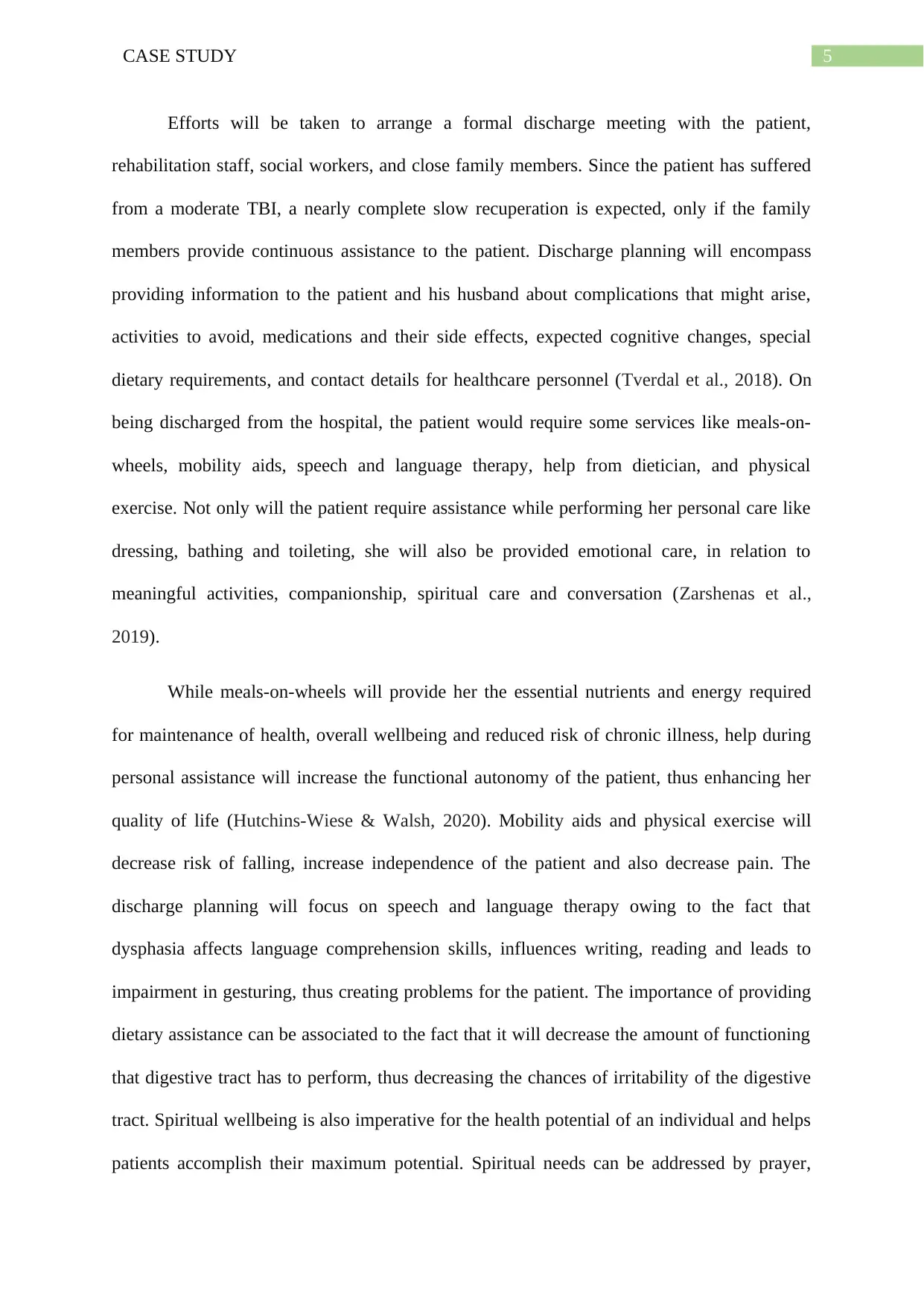
5CASE STUDY
Efforts will be taken to arrange a formal discharge meeting with the patient,
rehabilitation staff, social workers, and close family members. Since the patient has suffered
from a moderate TBI, a nearly complete slow recuperation is expected, only if the family
members provide continuous assistance to the patient. Discharge planning will encompass
providing information to the patient and his husband about complications that might arise,
activities to avoid, medications and their side effects, expected cognitive changes, special
dietary requirements, and contact details for healthcare personnel (Tverdal et al., 2018). On
being discharged from the hospital, the patient would require some services like meals-on-
wheels, mobility aids, speech and language therapy, help from dietician, and physical
exercise. Not only will the patient require assistance while performing her personal care like
dressing, bathing and toileting, she will also be provided emotional care, in relation to
meaningful activities, companionship, spiritual care and conversation (Zarshenas et al.,
2019).
While meals-on-wheels will provide her the essential nutrients and energy required
for maintenance of health, overall wellbeing and reduced risk of chronic illness, help during
personal assistance will increase the functional autonomy of the patient, thus enhancing her
quality of life (Hutchins-Wiese & Walsh, 2020). Mobility aids and physical exercise will
decrease risk of falling, increase independence of the patient and also decrease pain. The
discharge planning will focus on speech and language therapy owing to the fact that
dysphasia affects language comprehension skills, influences writing, reading and leads to
impairment in gesturing, thus creating problems for the patient. The importance of providing
dietary assistance can be associated to the fact that it will decrease the amount of functioning
that digestive tract has to perform, thus decreasing the chances of irritability of the digestive
tract. Spiritual wellbeing is also imperative for the health potential of an individual and helps
patients accomplish their maximum potential. Spiritual needs can be addressed by prayer,
Efforts will be taken to arrange a formal discharge meeting with the patient,
rehabilitation staff, social workers, and close family members. Since the patient has suffered
from a moderate TBI, a nearly complete slow recuperation is expected, only if the family
members provide continuous assistance to the patient. Discharge planning will encompass
providing information to the patient and his husband about complications that might arise,
activities to avoid, medications and their side effects, expected cognitive changes, special
dietary requirements, and contact details for healthcare personnel (Tverdal et al., 2018). On
being discharged from the hospital, the patient would require some services like meals-on-
wheels, mobility aids, speech and language therapy, help from dietician, and physical
exercise. Not only will the patient require assistance while performing her personal care like
dressing, bathing and toileting, she will also be provided emotional care, in relation to
meaningful activities, companionship, spiritual care and conversation (Zarshenas et al.,
2019).
While meals-on-wheels will provide her the essential nutrients and energy required
for maintenance of health, overall wellbeing and reduced risk of chronic illness, help during
personal assistance will increase the functional autonomy of the patient, thus enhancing her
quality of life (Hutchins-Wiese & Walsh, 2020). Mobility aids and physical exercise will
decrease risk of falling, increase independence of the patient and also decrease pain. The
discharge planning will focus on speech and language therapy owing to the fact that
dysphasia affects language comprehension skills, influences writing, reading and leads to
impairment in gesturing, thus creating problems for the patient. The importance of providing
dietary assistance can be associated to the fact that it will decrease the amount of functioning
that digestive tract has to perform, thus decreasing the chances of irritability of the digestive
tract. Spiritual wellbeing is also imperative for the health potential of an individual and helps
patients accomplish their maximum potential. Spiritual needs can be addressed by prayer,
⊘ This is a preview!⊘
Do you want full access?
Subscribe today to unlock all pages.

Trusted by 1+ million students worldwide
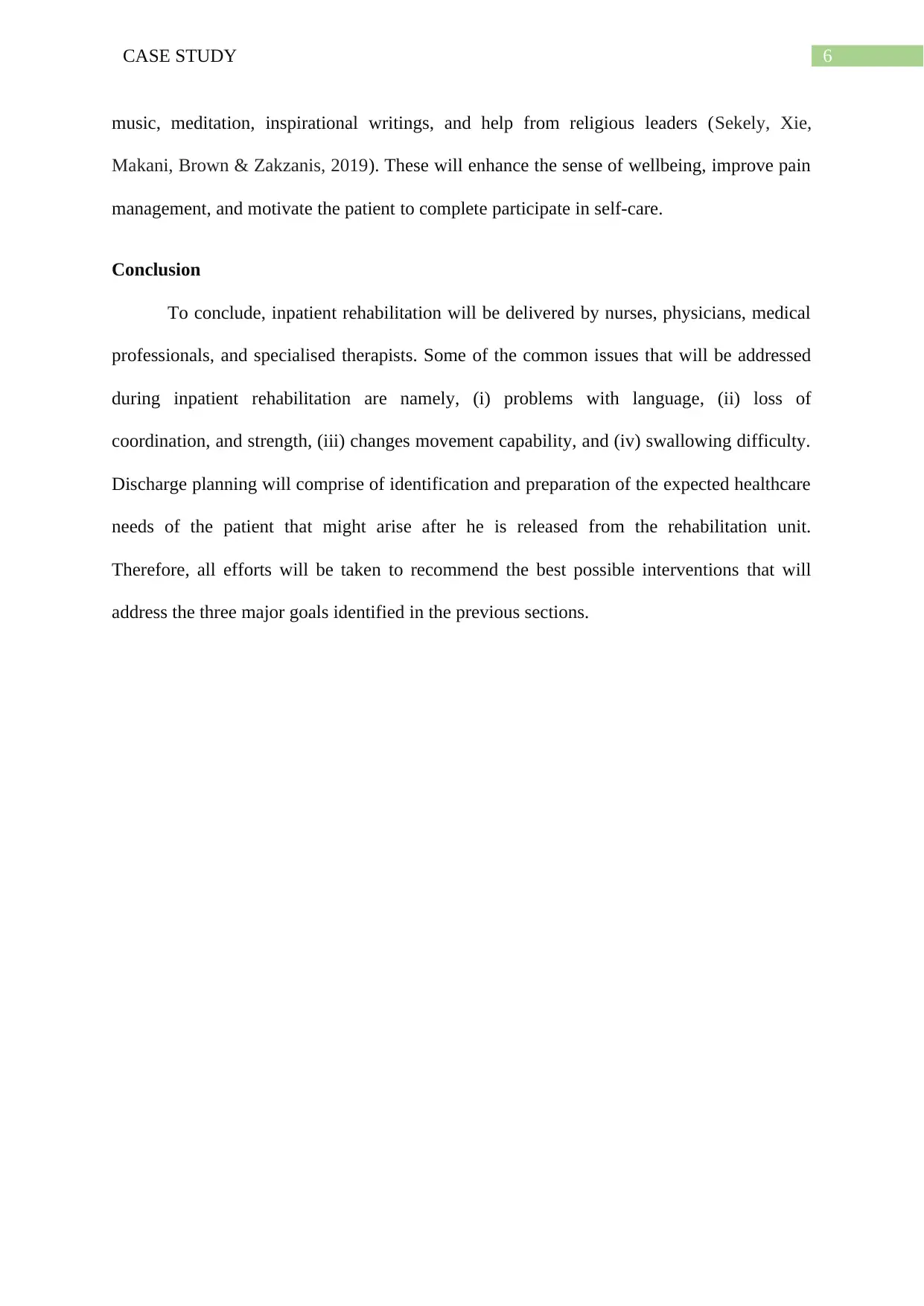
6CASE STUDY
music, meditation, inspirational writings, and help from religious leaders (Sekely, Xie,
Makani, Brown & Zakzanis, 2019). These will enhance the sense of wellbeing, improve pain
management, and motivate the patient to complete participate in self-care.
Conclusion
To conclude, inpatient rehabilitation will be delivered by nurses, physicians, medical
professionals, and specialised therapists. Some of the common issues that will be addressed
during inpatient rehabilitation are namely, (i) problems with language, (ii) loss of
coordination, and strength, (iii) changes movement capability, and (iv) swallowing difficulty.
Discharge planning will comprise of identification and preparation of the expected healthcare
needs of the patient that might arise after he is released from the rehabilitation unit.
Therefore, all efforts will be taken to recommend the best possible interventions that will
address the three major goals identified in the previous sections.
music, meditation, inspirational writings, and help from religious leaders (Sekely, Xie,
Makani, Brown & Zakzanis, 2019). These will enhance the sense of wellbeing, improve pain
management, and motivate the patient to complete participate in self-care.
Conclusion
To conclude, inpatient rehabilitation will be delivered by nurses, physicians, medical
professionals, and specialised therapists. Some of the common issues that will be addressed
during inpatient rehabilitation are namely, (i) problems with language, (ii) loss of
coordination, and strength, (iii) changes movement capability, and (iv) swallowing difficulty.
Discharge planning will comprise of identification and preparation of the expected healthcare
needs of the patient that might arise after he is released from the rehabilitation unit.
Therefore, all efforts will be taken to recommend the best possible interventions that will
address the three major goals identified in the previous sections.
Paraphrase This Document
Need a fresh take? Get an instant paraphrase of this document with our AI Paraphraser
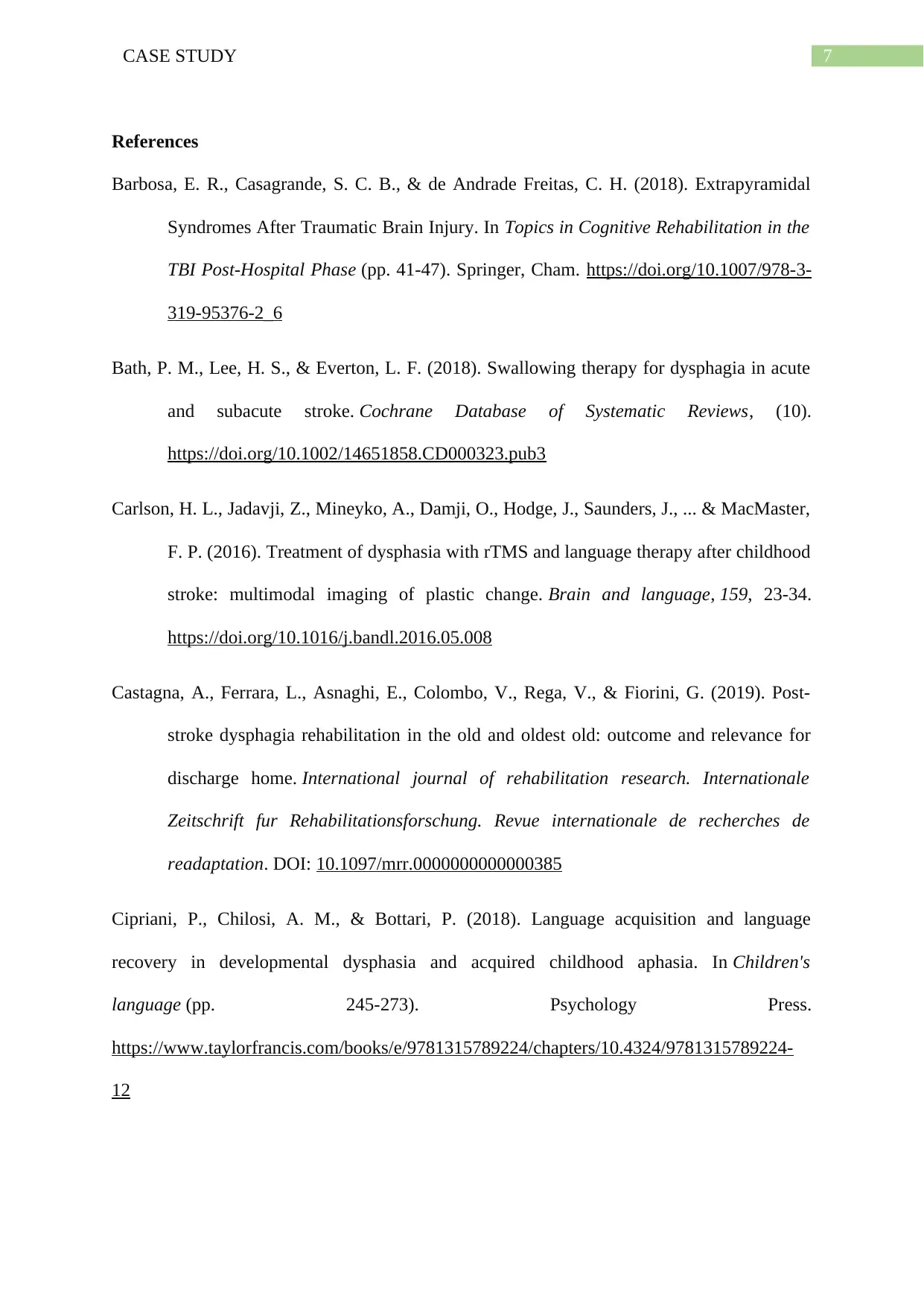
7CASE STUDY
References
Barbosa, E. R., Casagrande, S. C. B., & de Andrade Freitas, C. H. (2018). Extrapyramidal
Syndromes After Traumatic Brain Injury. In Topics in Cognitive Rehabilitation in the
TBI Post-Hospital Phase (pp. 41-47). Springer, Cham. https://doi.org/10.1007/978-3-
319-95376-2_6
Bath, P. M., Lee, H. S., & Everton, L. F. (2018). Swallowing therapy for dysphagia in acute
and subacute stroke. Cochrane Database of Systematic Reviews, (10).
https://doi.org/10.1002/14651858.CD000323.pub3
Carlson, H. L., Jadavji, Z., Mineyko, A., Damji, O., Hodge, J., Saunders, J., ... & MacMaster,
F. P. (2016). Treatment of dysphasia with rTMS and language therapy after childhood
stroke: multimodal imaging of plastic change. Brain and language, 159, 23-34.
https://doi.org/10.1016/j.bandl.2016.05.008
Castagna, A., Ferrara, L., Asnaghi, E., Colombo, V., Rega, V., & Fiorini, G. (2019). Post-
stroke dysphagia rehabilitation in the old and oldest old: outcome and relevance for
discharge home. International journal of rehabilitation research. Internationale
Zeitschrift fur Rehabilitationsforschung. Revue internationale de recherches de
readaptation. DOI: 10.1097/mrr.0000000000000385
Cipriani, P., Chilosi, A. M., & Bottari, P. (2018). Language acquisition and language
recovery in developmental dysphasia and acquired childhood aphasia. In Children's
language (pp. 245-273). Psychology Press.
https://www.taylorfrancis.com/books/e/9781315789224/chapters/10.4324/9781315789224-
12
References
Barbosa, E. R., Casagrande, S. C. B., & de Andrade Freitas, C. H. (2018). Extrapyramidal
Syndromes After Traumatic Brain Injury. In Topics in Cognitive Rehabilitation in the
TBI Post-Hospital Phase (pp. 41-47). Springer, Cham. https://doi.org/10.1007/978-3-
319-95376-2_6
Bath, P. M., Lee, H. S., & Everton, L. F. (2018). Swallowing therapy for dysphagia in acute
and subacute stroke. Cochrane Database of Systematic Reviews, (10).
https://doi.org/10.1002/14651858.CD000323.pub3
Carlson, H. L., Jadavji, Z., Mineyko, A., Damji, O., Hodge, J., Saunders, J., ... & MacMaster,
F. P. (2016). Treatment of dysphasia with rTMS and language therapy after childhood
stroke: multimodal imaging of plastic change. Brain and language, 159, 23-34.
https://doi.org/10.1016/j.bandl.2016.05.008
Castagna, A., Ferrara, L., Asnaghi, E., Colombo, V., Rega, V., & Fiorini, G. (2019). Post-
stroke dysphagia rehabilitation in the old and oldest old: outcome and relevance for
discharge home. International journal of rehabilitation research. Internationale
Zeitschrift fur Rehabilitationsforschung. Revue internationale de recherches de
readaptation. DOI: 10.1097/mrr.0000000000000385
Cipriani, P., Chilosi, A. M., & Bottari, P. (2018). Language acquisition and language
recovery in developmental dysphasia and acquired childhood aphasia. In Children's
language (pp. 245-273). Psychology Press.
https://www.taylorfrancis.com/books/e/9781315789224/chapters/10.4324/9781315789224-
12
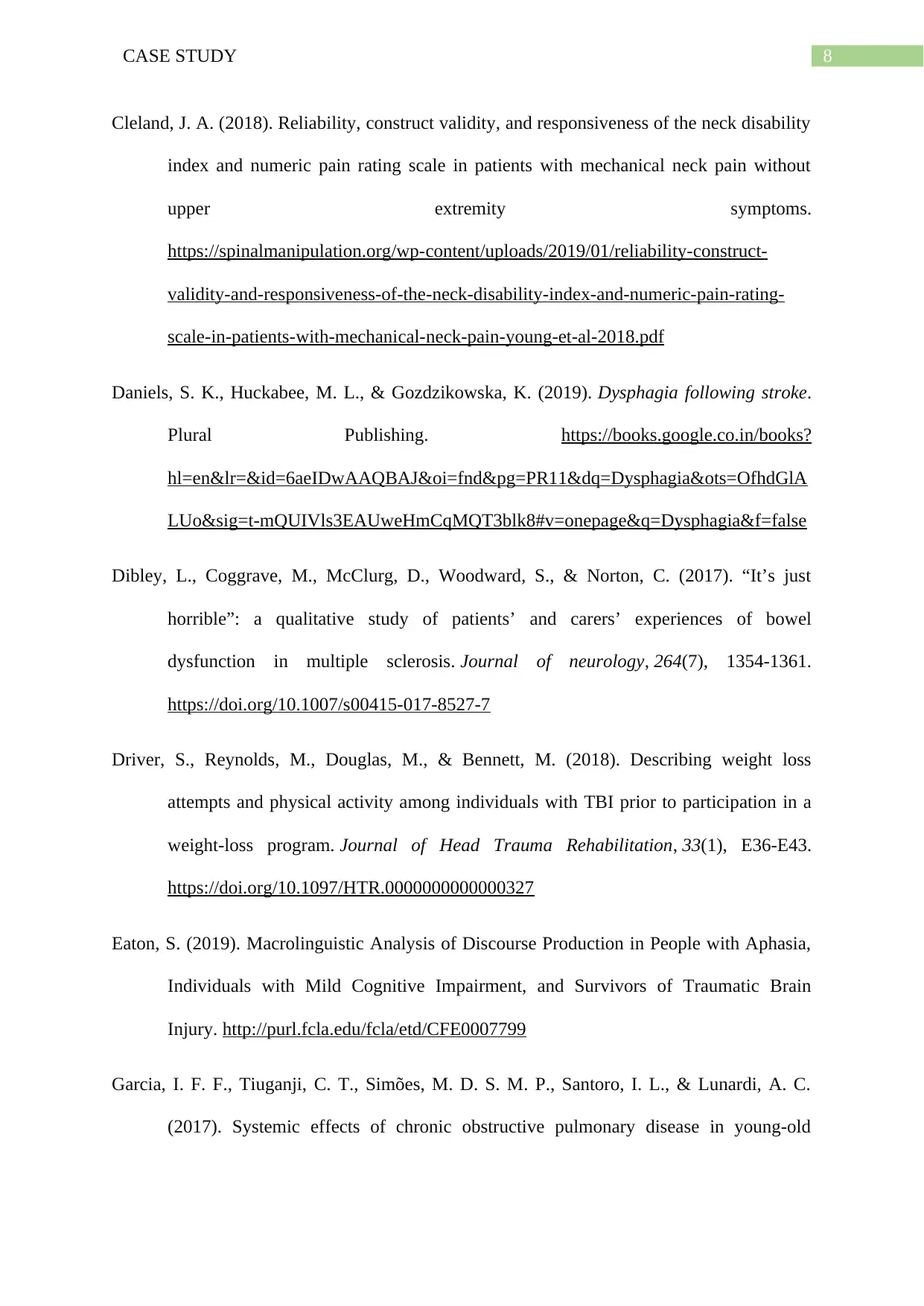
8CASE STUDY
Cleland, J. A. (2018). Reliability, construct validity, and responsiveness of the neck disability
index and numeric pain rating scale in patients with mechanical neck pain without
upper extremity symptoms.
https://spinalmanipulation.org/wp-content/uploads/2019/01/reliability-construct-
validity-and-responsiveness-of-the-neck-disability-index-and-numeric-pain-rating-
scale-in-patients-with-mechanical-neck-pain-young-et-al-2018.pdf
Daniels, S. K., Huckabee, M. L., & Gozdzikowska, K. (2019). Dysphagia following stroke.
Plural Publishing. https://books.google.co.in/books?
hl=en&lr=&id=6aeIDwAAQBAJ&oi=fnd&pg=PR11&dq=Dysphagia&ots=OfhdGlA
LUo&sig=t-mQUIVls3EAUweHmCqMQT3blk8#v=onepage&q=Dysphagia&f=false
Dibley, L., Coggrave, M., McClurg, D., Woodward, S., & Norton, C. (2017). “It’s just
horrible”: a qualitative study of patients’ and carers’ experiences of bowel
dysfunction in multiple sclerosis. Journal of neurology, 264(7), 1354-1361.
https://doi.org/10.1007/s00415-017-8527-7
Driver, S., Reynolds, M., Douglas, M., & Bennett, M. (2018). Describing weight loss
attempts and physical activity among individuals with TBI prior to participation in a
weight-loss program. Journal of Head Trauma Rehabilitation, 33(1), E36-E43.
https://doi.org/10.1097/HTR.0000000000000327
Eaton, S. (2019). Macrolinguistic Analysis of Discourse Production in People with Aphasia,
Individuals with Mild Cognitive Impairment, and Survivors of Traumatic Brain
Injury. http://purl.fcla.edu/fcla/etd/CFE0007799
Garcia, I. F. F., Tiuganji, C. T., Simões, M. D. S. M. P., Santoro, I. L., & Lunardi, A. C.
(2017). Systemic effects of chronic obstructive pulmonary disease in young-old
Cleland, J. A. (2018). Reliability, construct validity, and responsiveness of the neck disability
index and numeric pain rating scale in patients with mechanical neck pain without
upper extremity symptoms.
https://spinalmanipulation.org/wp-content/uploads/2019/01/reliability-construct-
validity-and-responsiveness-of-the-neck-disability-index-and-numeric-pain-rating-
scale-in-patients-with-mechanical-neck-pain-young-et-al-2018.pdf
Daniels, S. K., Huckabee, M. L., & Gozdzikowska, K. (2019). Dysphagia following stroke.
Plural Publishing. https://books.google.co.in/books?
hl=en&lr=&id=6aeIDwAAQBAJ&oi=fnd&pg=PR11&dq=Dysphagia&ots=OfhdGlA
LUo&sig=t-mQUIVls3EAUweHmCqMQT3blk8#v=onepage&q=Dysphagia&f=false
Dibley, L., Coggrave, M., McClurg, D., Woodward, S., & Norton, C. (2017). “It’s just
horrible”: a qualitative study of patients’ and carers’ experiences of bowel
dysfunction in multiple sclerosis. Journal of neurology, 264(7), 1354-1361.
https://doi.org/10.1007/s00415-017-8527-7
Driver, S., Reynolds, M., Douglas, M., & Bennett, M. (2018). Describing weight loss
attempts and physical activity among individuals with TBI prior to participation in a
weight-loss program. Journal of Head Trauma Rehabilitation, 33(1), E36-E43.
https://doi.org/10.1097/HTR.0000000000000327
Eaton, S. (2019). Macrolinguistic Analysis of Discourse Production in People with Aphasia,
Individuals with Mild Cognitive Impairment, and Survivors of Traumatic Brain
Injury. http://purl.fcla.edu/fcla/etd/CFE0007799
Garcia, I. F. F., Tiuganji, C. T., Simões, M. D. S. M. P., Santoro, I. L., & Lunardi, A. C.
(2017). Systemic effects of chronic obstructive pulmonary disease in young-old
⊘ This is a preview!⊘
Do you want full access?
Subscribe today to unlock all pages.

Trusted by 1+ million students worldwide
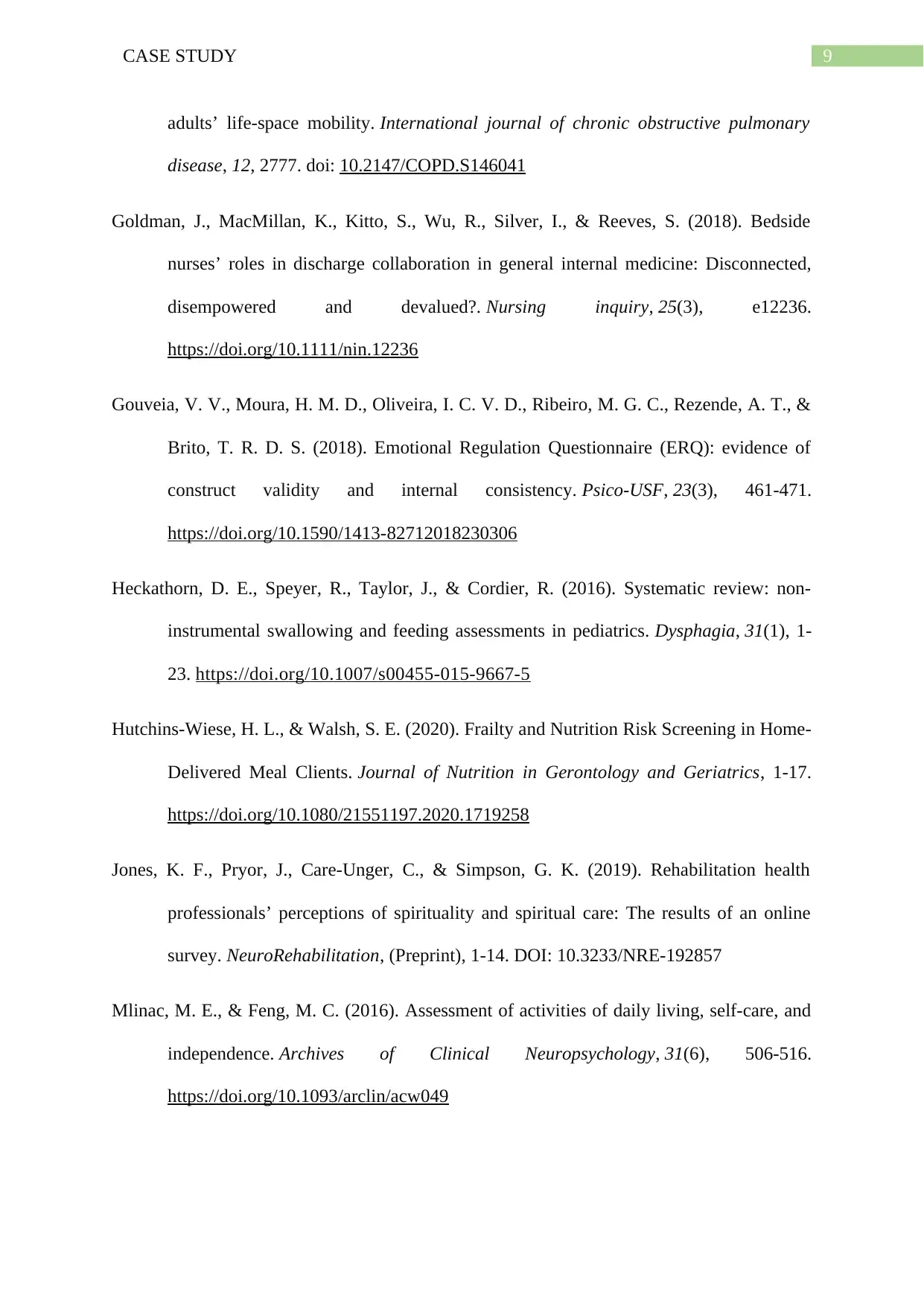
9CASE STUDY
adults’ life-space mobility. International journal of chronic obstructive pulmonary
disease, 12, 2777. doi: 10.2147/COPD.S146041
Goldman, J., MacMillan, K., Kitto, S., Wu, R., Silver, I., & Reeves, S. (2018). Bedside
nurses’ roles in discharge collaboration in general internal medicine: Disconnected,
disempowered and devalued?. Nursing inquiry, 25(3), e12236.
https://doi.org/10.1111/nin.12236
Gouveia, V. V., Moura, H. M. D., Oliveira, I. C. V. D., Ribeiro, M. G. C., Rezende, A. T., &
Brito, T. R. D. S. (2018). Emotional Regulation Questionnaire (ERQ): evidence of
construct validity and internal consistency. Psico-USF, 23(3), 461-471.
https://doi.org/10.1590/1413-82712018230306
Heckathorn, D. E., Speyer, R., Taylor, J., & Cordier, R. (2016). Systematic review: non-
instrumental swallowing and feeding assessments in pediatrics. Dysphagia, 31(1), 1-
23. https://doi.org/10.1007/s00455-015-9667-5
Hutchins-Wiese, H. L., & Walsh, S. E. (2020). Frailty and Nutrition Risk Screening in Home-
Delivered Meal Clients. Journal of Nutrition in Gerontology and Geriatrics, 1-17.
https://doi.org/10.1080/21551197.2020.1719258
Jones, K. F., Pryor, J., Care-Unger, C., & Simpson, G. K. (2019). Rehabilitation health
professionals’ perceptions of spirituality and spiritual care: The results of an online
survey. NeuroRehabilitation, (Preprint), 1-14. DOI: 10.3233/NRE-192857
Mlinac, M. E., & Feng, M. C. (2016). Assessment of activities of daily living, self-care, and
independence. Archives of Clinical Neuropsychology, 31(6), 506-516.
https://doi.org/10.1093/arclin/acw049
adults’ life-space mobility. International journal of chronic obstructive pulmonary
disease, 12, 2777. doi: 10.2147/COPD.S146041
Goldman, J., MacMillan, K., Kitto, S., Wu, R., Silver, I., & Reeves, S. (2018). Bedside
nurses’ roles in discharge collaboration in general internal medicine: Disconnected,
disempowered and devalued?. Nursing inquiry, 25(3), e12236.
https://doi.org/10.1111/nin.12236
Gouveia, V. V., Moura, H. M. D., Oliveira, I. C. V. D., Ribeiro, M. G. C., Rezende, A. T., &
Brito, T. R. D. S. (2018). Emotional Regulation Questionnaire (ERQ): evidence of
construct validity and internal consistency. Psico-USF, 23(3), 461-471.
https://doi.org/10.1590/1413-82712018230306
Heckathorn, D. E., Speyer, R., Taylor, J., & Cordier, R. (2016). Systematic review: non-
instrumental swallowing and feeding assessments in pediatrics. Dysphagia, 31(1), 1-
23. https://doi.org/10.1007/s00455-015-9667-5
Hutchins-Wiese, H. L., & Walsh, S. E. (2020). Frailty and Nutrition Risk Screening in Home-
Delivered Meal Clients. Journal of Nutrition in Gerontology and Geriatrics, 1-17.
https://doi.org/10.1080/21551197.2020.1719258
Jones, K. F., Pryor, J., Care-Unger, C., & Simpson, G. K. (2019). Rehabilitation health
professionals’ perceptions of spirituality and spiritual care: The results of an online
survey. NeuroRehabilitation, (Preprint), 1-14. DOI: 10.3233/NRE-192857
Mlinac, M. E., & Feng, M. C. (2016). Assessment of activities of daily living, self-care, and
independence. Archives of Clinical Neuropsychology, 31(6), 506-516.
https://doi.org/10.1093/arclin/acw049
Paraphrase This Document
Need a fresh take? Get an instant paraphrase of this document with our AI Paraphraser
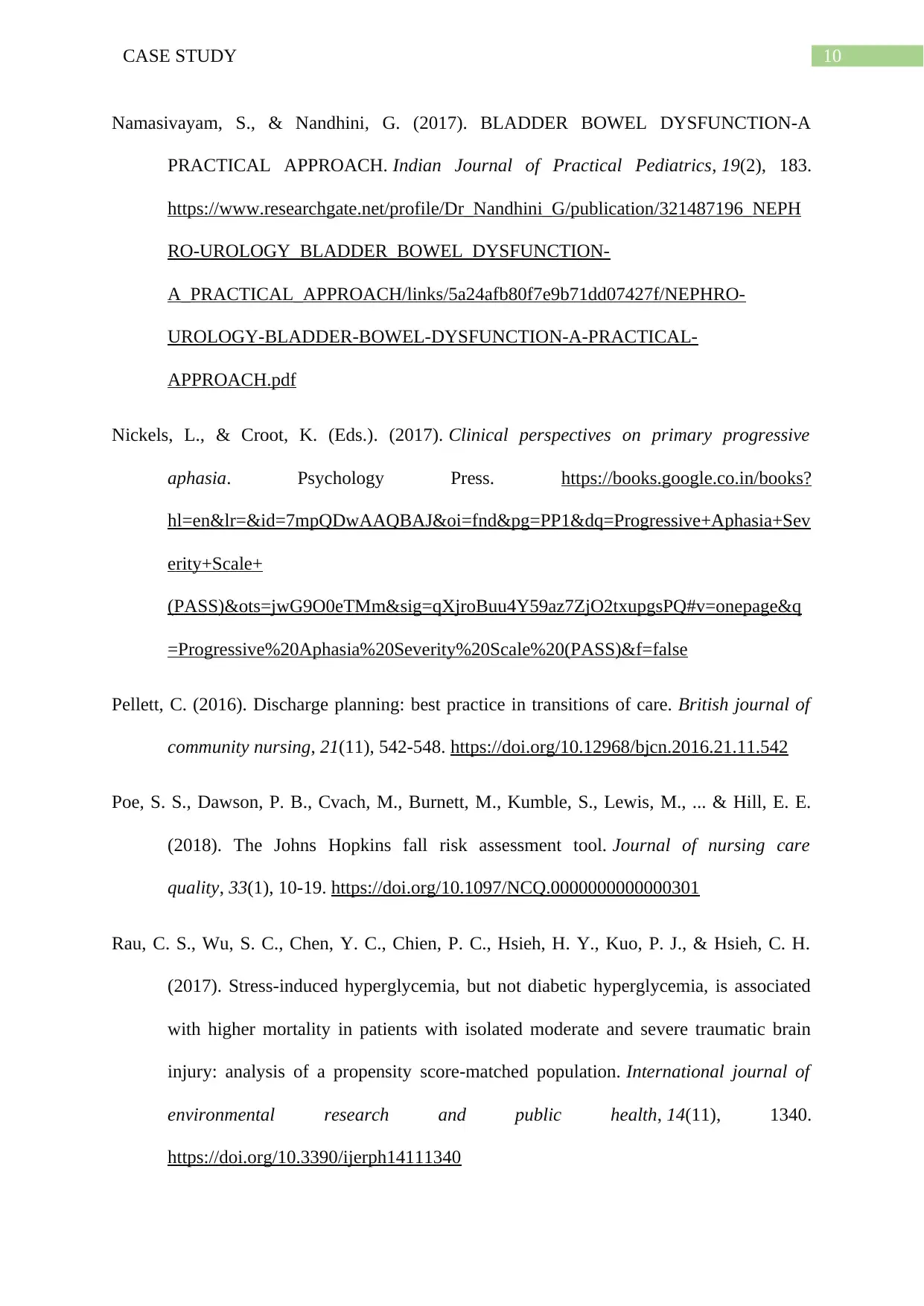
10CASE STUDY
Namasivayam, S., & Nandhini, G. (2017). BLADDER BOWEL DYSFUNCTION-A
PRACTICAL APPROACH. Indian Journal of Practical Pediatrics, 19(2), 183.
https://www.researchgate.net/profile/Dr_Nandhini_G/publication/321487196_NEPH
RO-UROLOGY_BLADDER_BOWEL_DYSFUNCTION-
A_PRACTICAL_APPROACH/links/5a24afb80f7e9b71dd07427f/NEPHRO-
UROLOGY-BLADDER-BOWEL-DYSFUNCTION-A-PRACTICAL-
APPROACH.pdf
Nickels, L., & Croot, K. (Eds.). (2017). Clinical perspectives on primary progressive
aphasia. Psychology Press. https://books.google.co.in/books?
hl=en&lr=&id=7mpQDwAAQBAJ&oi=fnd&pg=PP1&dq=Progressive+Aphasia+Sev
erity+Scale+
(PASS)&ots=jwG9O0eTMm&sig=qXjroBuu4Y59az7ZjO2txupgsPQ#v=onepage&q
=Progressive%20Aphasia%20Severity%20Scale%20(PASS)&f=false
Pellett, C. (2016). Discharge planning: best practice in transitions of care. British journal of
community nursing, 21(11), 542-548. https://doi.org/10.12968/bjcn.2016.21.11.542
Poe, S. S., Dawson, P. B., Cvach, M., Burnett, M., Kumble, S., Lewis, M., ... & Hill, E. E.
(2018). The Johns Hopkins fall risk assessment tool. Journal of nursing care
quality, 33(1), 10-19. https://doi.org/10.1097/NCQ.0000000000000301
Rau, C. S., Wu, S. C., Chen, Y. C., Chien, P. C., Hsieh, H. Y., Kuo, P. J., & Hsieh, C. H.
(2017). Stress-induced hyperglycemia, but not diabetic hyperglycemia, is associated
with higher mortality in patients with isolated moderate and severe traumatic brain
injury: analysis of a propensity score-matched population. International journal of
environmental research and public health, 14(11), 1340.
https://doi.org/10.3390/ijerph14111340
Namasivayam, S., & Nandhini, G. (2017). BLADDER BOWEL DYSFUNCTION-A
PRACTICAL APPROACH. Indian Journal of Practical Pediatrics, 19(2), 183.
https://www.researchgate.net/profile/Dr_Nandhini_G/publication/321487196_NEPH
RO-UROLOGY_BLADDER_BOWEL_DYSFUNCTION-
A_PRACTICAL_APPROACH/links/5a24afb80f7e9b71dd07427f/NEPHRO-
UROLOGY-BLADDER-BOWEL-DYSFUNCTION-A-PRACTICAL-
APPROACH.pdf
Nickels, L., & Croot, K. (Eds.). (2017). Clinical perspectives on primary progressive
aphasia. Psychology Press. https://books.google.co.in/books?
hl=en&lr=&id=7mpQDwAAQBAJ&oi=fnd&pg=PP1&dq=Progressive+Aphasia+Sev
erity+Scale+
(PASS)&ots=jwG9O0eTMm&sig=qXjroBuu4Y59az7ZjO2txupgsPQ#v=onepage&q
=Progressive%20Aphasia%20Severity%20Scale%20(PASS)&f=false
Pellett, C. (2016). Discharge planning: best practice in transitions of care. British journal of
community nursing, 21(11), 542-548. https://doi.org/10.12968/bjcn.2016.21.11.542
Poe, S. S., Dawson, P. B., Cvach, M., Burnett, M., Kumble, S., Lewis, M., ... & Hill, E. E.
(2018). The Johns Hopkins fall risk assessment tool. Journal of nursing care
quality, 33(1), 10-19. https://doi.org/10.1097/NCQ.0000000000000301
Rau, C. S., Wu, S. C., Chen, Y. C., Chien, P. C., Hsieh, H. Y., Kuo, P. J., & Hsieh, C. H.
(2017). Stress-induced hyperglycemia, but not diabetic hyperglycemia, is associated
with higher mortality in patients with isolated moderate and severe traumatic brain
injury: analysis of a propensity score-matched population. International journal of
environmental research and public health, 14(11), 1340.
https://doi.org/10.3390/ijerph14111340
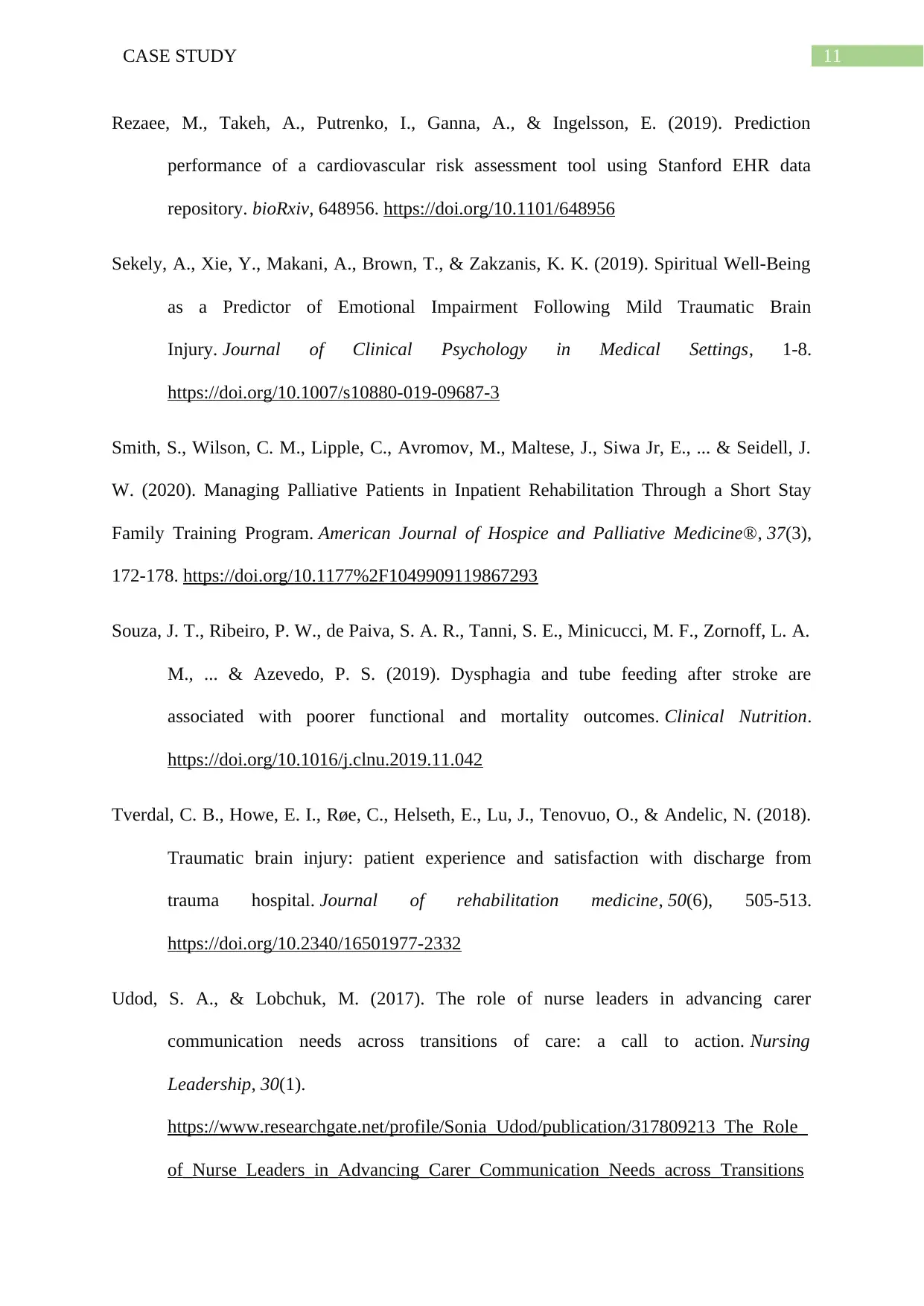
11CASE STUDY
Rezaee, M., Takeh, A., Putrenko, I., Ganna, A., & Ingelsson, E. (2019). Prediction
performance of a cardiovascular risk assessment tool using Stanford EHR data
repository. bioRxiv, 648956. https://doi.org/10.1101/648956
Sekely, A., Xie, Y., Makani, A., Brown, T., & Zakzanis, K. K. (2019). Spiritual Well-Being
as a Predictor of Emotional Impairment Following Mild Traumatic Brain
Injury. Journal of Clinical Psychology in Medical Settings, 1-8.
https://doi.org/10.1007/s10880-019-09687-3
Smith, S., Wilson, C. M., Lipple, C., Avromov, M., Maltese, J., Siwa Jr, E., ... & Seidell, J.
W. (2020). Managing Palliative Patients in Inpatient Rehabilitation Through a Short Stay
Family Training Program. American Journal of Hospice and Palliative Medicine®, 37(3),
172-178. https://doi.org/10.1177%2F1049909119867293
Souza, J. T., Ribeiro, P. W., de Paiva, S. A. R., Tanni, S. E., Minicucci, M. F., Zornoff, L. A.
M., ... & Azevedo, P. S. (2019). Dysphagia and tube feeding after stroke are
associated with poorer functional and mortality outcomes. Clinical Nutrition.
https://doi.org/10.1016/j.clnu.2019.11.042
Tverdal, C. B., Howe, E. I., Røe, C., Helseth, E., Lu, J., Tenovuo, O., & Andelic, N. (2018).
Traumatic brain injury: patient experience and satisfaction with discharge from
trauma hospital. Journal of rehabilitation medicine, 50(6), 505-513.
https://doi.org/10.2340/16501977-2332
Udod, S. A., & Lobchuk, M. (2017). The role of nurse leaders in advancing carer
communication needs across transitions of care: a call to action. Nursing
Leadership, 30(1).
https://www.researchgate.net/profile/Sonia_Udod/publication/317809213_The_Role_
of_Nurse_Leaders_in_Advancing_Carer_Communication_Needs_across_Transitions
Rezaee, M., Takeh, A., Putrenko, I., Ganna, A., & Ingelsson, E. (2019). Prediction
performance of a cardiovascular risk assessment tool using Stanford EHR data
repository. bioRxiv, 648956. https://doi.org/10.1101/648956
Sekely, A., Xie, Y., Makani, A., Brown, T., & Zakzanis, K. K. (2019). Spiritual Well-Being
as a Predictor of Emotional Impairment Following Mild Traumatic Brain
Injury. Journal of Clinical Psychology in Medical Settings, 1-8.
https://doi.org/10.1007/s10880-019-09687-3
Smith, S., Wilson, C. M., Lipple, C., Avromov, M., Maltese, J., Siwa Jr, E., ... & Seidell, J.
W. (2020). Managing Palliative Patients in Inpatient Rehabilitation Through a Short Stay
Family Training Program. American Journal of Hospice and Palliative Medicine®, 37(3),
172-178. https://doi.org/10.1177%2F1049909119867293
Souza, J. T., Ribeiro, P. W., de Paiva, S. A. R., Tanni, S. E., Minicucci, M. F., Zornoff, L. A.
M., ... & Azevedo, P. S. (2019). Dysphagia and tube feeding after stroke are
associated with poorer functional and mortality outcomes. Clinical Nutrition.
https://doi.org/10.1016/j.clnu.2019.11.042
Tverdal, C. B., Howe, E. I., Røe, C., Helseth, E., Lu, J., Tenovuo, O., & Andelic, N. (2018).
Traumatic brain injury: patient experience and satisfaction with discharge from
trauma hospital. Journal of rehabilitation medicine, 50(6), 505-513.
https://doi.org/10.2340/16501977-2332
Udod, S. A., & Lobchuk, M. (2017). The role of nurse leaders in advancing carer
communication needs across transitions of care: a call to action. Nursing
Leadership, 30(1).
https://www.researchgate.net/profile/Sonia_Udod/publication/317809213_The_Role_
of_Nurse_Leaders_in_Advancing_Carer_Communication_Needs_across_Transitions
⊘ This is a preview!⊘
Do you want full access?
Subscribe today to unlock all pages.

Trusted by 1+ million students worldwide
1 out of 13
Related Documents
Your All-in-One AI-Powered Toolkit for Academic Success.
+13062052269
info@desklib.com
Available 24*7 on WhatsApp / Email
![[object Object]](/_next/static/media/star-bottom.7253800d.svg)
Unlock your academic potential
Copyright © 2020–2025 A2Z Services. All Rights Reserved. Developed and managed by ZUCOL.



